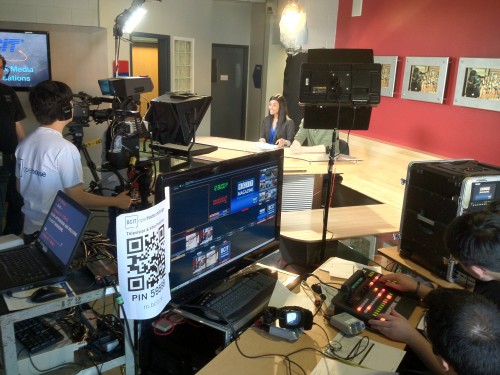Our first-year students from the TV and Journalism programs spent the last week putting together Friday’s episode of BCIT Magazine.
Here are some behind-the-scenes production photos
Our second-year students have spent some time developing a short 30-second promotional video for the Television & Video Production Program.
It’s hard to get a sense of how challenging and exciting our program is, but they took a good shot at it!
BCIT’s 2012 Open House is on now!
Join us Friday April 13th and Saturday April 14th – 9am to 4pm

Drop by the Broadcast & Media Communications Department in building SE10 and see all of our programs in action:
- Radio
- Television & Video Production
- Broadcast & Online Journalism
We have many live demos and activities where you can try your own hand at broadcasting!
One of our annual first-year activities in the Television & Video Production Program is touring our students through various Television stations (and maybe some other stops!) in the lower mainland.

Not only do the tours give our students a chance to see the operations and equipment behind the scenes at local broadcasters, they’re generally the first chance our students have to meet the staff and develop the connections that can lead to a job!
Of course, it’s always a benefit to our staff as well, who get to reconnect with our alumni and see what they’re doing now. At CTV today, we ran into quite a few BCIT Alumni: Carl, Kim, Jeannine, Johnny, and Derek. And there’s another half-dozen or so grads who we missed due to the timing of our afternoon visit (Jenn, Sam, Ara and a few others!). One of the great strengths of our program is our network of industry connections!
So it’s been a bit of time since the last update, mostly because it’s been very, very busy in the Broadcast Department at BCIT. Our programs have all been undergoing curriculum reviews to ensure that we’re delivering content that matches employer and student needs alike – it’s an ongoing process to help deliver the best Broadcast education in Western Canada!
We have also undergone a number of staffing changes, including welcoming Randy Singer as the Acting Associate Dean for the Broadcast Department, as well as a number of new instructors who are teaching into the Television Program this term:
- Michael Moss – Technical Introduction
- Dan Moscript – Production Planning
- Dave Berenbaum – Post Production (Avid Media Composer)
- John Foster – Organizational Behaviour
And just a few quick photos from this week, showing what our new students, and our returning second-years are up to in their first week of class!

The Max Headroom TV series premiered back in 1987 and was one of the first “Cyberpunk” television shows. The story lines having to do with huge international television / broadcast networks controlling culture and politics were at least 10 or 15 years ahead of their time.
Nobody would argue that mainstream media has a vast influence on these things today!
One of the fascinating things about the fictional “Network 23”, was the idea that all of the camera operators would have continual real time feeds from their portable cameras back to the network. Directors could see the output of any camera at any time, and see their exact location on a map – all in real time.
This type of portable technology was unheard of back in the late 80s, when large satellite uplinks and microwave vans were required to get video back to the station from remote locations.
Fast-forward to 2010, and an update to Sony’s “Location Porter” system looks to be enabling exactly that kind of connectivity, now on a large-scale basis.

Broadcasters have had the capability to use small mobile transmitters and VOIP systems to deliver video for a few years now, but this system takes it up a notch with a turnkey system that enables real time video/audio streaming for up to 12 sources (cameras, remotes, etc) at the same time at the push of a button.

Because it uses high-speed mobile data networks for connectivity, it’s relatively cheap compared with conventional systems. It’s no longer a matter of shooting a story and delivering media back at a later time, but realtime capture right onto a live show, or into an editorial system.
Maybe the future of broadcast news isn’t getting a single camera to an event and trying to cover everything at one, but to get a “swarm” of networked realtime cameras that feed everything and anything back simultaneously.





















